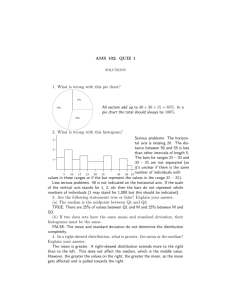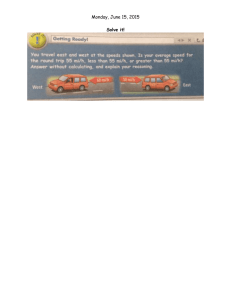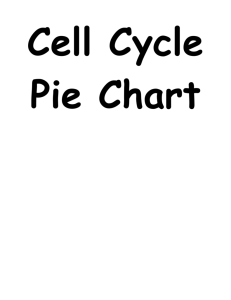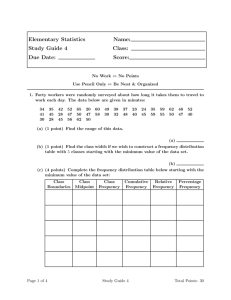KS3: Stem and Leaf Diagrams
advertisement
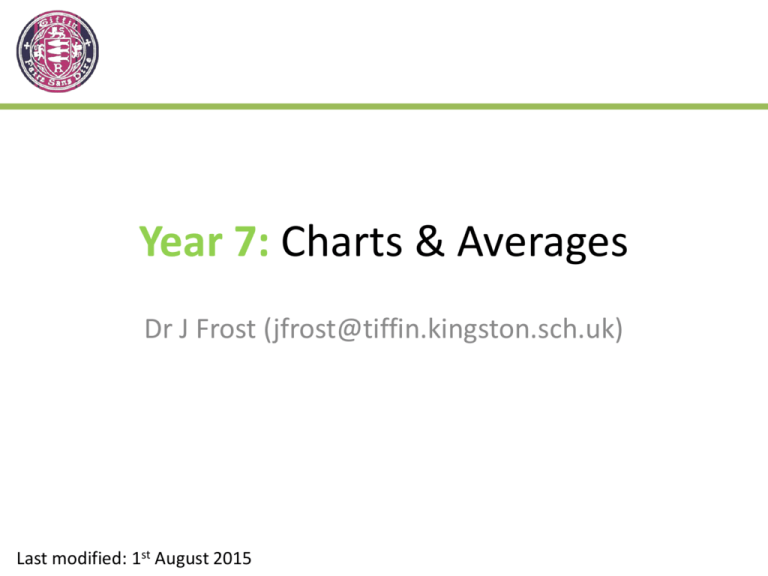
Year 7: Charts & Averages Dr J Frost (jfrost@tiffin.kingston.sch.uk) Last modified: 1st August 2015 For Teacher Use: Recommended lesson structure: Lesson 1: Introduction. Pie charts. Lesson 2: Frequency Diagrams (Bar Charts vs Histograms, Frequency Polygons) Lesson 3: Averages (from listed data) and range. Lesson 4: Stem and Leaf Lesson 5: Mean of frequency table/Estimated mean of grouped data. Combined means. Go > Go > Go > Go > Go > Ways of Displaying Data In pairs, try and think of all the different types of ‘charts’ and diagrams you could use to display data. Frequency Diagrams Pie charts (Covered in KS2, Year 7) Frequency Polygons Bar charts (Covered in Year 7, 8) (Covered in KS2) Histogram (Covered at GCSE) Stem & Leaf Diagrams (Covered in Year 7, 8) Pictogram (Covered in KS2) Box Plot (Covered in Year 8) Cumulative Frequency Graphs (Covered in Year 8) Year 7 Pie Charts Dr J Frost (jfrost@tiffin.kingston.sch.uk) Pie Charts For which sets of data is a pie chart suitable, and which are not (and why?) If not, suggest a better way to display this data. Goals so far this season by top 4 teams Pie charts should be used when we interested in proportions/percentage/fractions of some total and are less concerned with the frequencies. The fraction of the total goals of the four teams is not particularly significant here, it’s the number of goals (i.e. the frequencies) we’re more interested in. A more suitable representation would be a bar chart: Goals so far this season by top 4 teams ? 50 45 40 35 30 25 20 Chelsea Arsenal QPR The Bickerstaffs 15 10 5 0 Chelsea Arsenal QPR The Bickerstaffs Pie Charts For which sets of data is a pie chart suitable, and which are not (and why?) If not, suggest a better way to display this data. Hours Dr Frost spends doing this activity on a typical day Year 7's Favourite Colour 10% 17% 25% 42% 6% Sleep Travel Eat PS4 Work Giving Detentions Yes this is suitable. We’re interested in what proportion of a day Dr Frost is doing different things. ? Bro Tip: Don’t use a pie if either: (a) There’s not a clear total for which we can have fractions of. (b) The pie chart wouldn’t work if we were to omit the frequencies. Red Blue Green Taupe Other Yes this is suitable. We’re interested in what proportion of Year 7 who like each of the colours. The percentages here are more ? important than the frequencies. Frequencies ↔ Angles To work out frequencies from the angles, simply see what fraction of a full circle the slice occupies. Favourite Colour Frequency Red 20 ? Green 60 ? Blue 120 ? TOTAL 200 Best Event Frequency Heptathlon 40 Pentathlon 17 Icoasathlon 63 TOTAL 120 Favourite Colour Fraction Angle 1 ? 10 3 ? 10 6 ? 10 36° 108° 216° Red 1 Green Blue 1 36° is 10 of 360°. So if a 10 of the 200 people like red… Fraction Angle 1 ? 3 17 ? 120 63 ? 120 36° ? 51° ? 189° ? It’s exactly the same principle the other way round. Frequencies ↔ Angles Favourite Colour Frequency Angle Red 50 32° Green 75 48° ? TOTAL ? 75 is half extra of 50, so half extra of 32° is 32 + 16 = 48° Even if the total isn’t available, we can find missing angles/frequencies by: a) Finding out what one person/degree is worth or b) Scaling. e.g. If the angle doubles, the frequency doubles, and so on. Test Your Understanding Instrument Frequency Violin 18 Piano 33 Trumpet 69 TOTAL 120 ? ? ? Fraction Angle ? 40 6 54° 11 ? 40 23 ? 40 99° 207° How to draw a super awesome pie chart Title Key Circle drawn with compass and lines drawn with ruler. ? ? Variants of pie charts Sectors labelled with percentages. Variants of pie charts Sectors labelled with percentages and values. No key. Calculating percentages and angles Squirrel Type Frequency Percentage Angle Red 49 30% 108° Grey 87 Black 23 Ferret (not a squirrel) 4 TOTAL 163 ? 53% ? 14% ? 3% ? 100% ? ? ? 191° ? 50° ? 11° ? 360° ? Exercise 1 1 (on provided sheet) 2 We’ll do the first one together... Favourite Colour Frequency Red 18 Blue Green Orange Fraction Angle 18 68° 27 96 27 42 96 42 9 96 9 96 ? ? ? ? ? 101° ? 158° ? 34° ? Favourite Colour Games Console Owned Frequency Fraction Angle 24 Wii U 24 34° PS3 Xbox 360 None ? ? ? ? 97 251 97 76 251 76 54 251 54 251 Games Console Owned ? ? (Pie chart using protractor and ruler) (Pie chart using protractor and ruler) Red Blue Green Orange Wii U PS3 Xbox 360 None ? 139° ? 109° ? 77° ? Exercise 1 (on provided sheet) 4 3 Holiday Destination Europe Frequency ? ? ? ? 11 11 43 25 25 Asia 43 6 6 Africa 43 1 1 Antarctica Fraction Angle 43 ? 209° ? 50° ? 8°? 92° Student continent of Origin Age of mother 16-30 Frequency Fraction ? ? ? ? 16 16 30-35 27 140 27 35-40 58 140 58 40+ 39 140 39 Angle ? 69° ? 149° ? 100° ? 41° 140 Age of mother ? ? (Pie chart using protractor and ruler) (Pie chart using protractor and ruler) Europe Asia Africa Antarctica 16-30 30-35 35-40 40+ Year 7 Frequency Diagrams Dr J Frost (jfrost@tiffin.kingston.sch.uk) Frequency Diagrams When we record data, we may record the number of times we saw a value (we’d use a ‘tally’ when collecting the data) – this is known as the frequency. A frequency table might show ungrouped or grouped data: Grouped Data Ungrouped Data Time 𝒕 (seconds) Shoe Size Frequency Frequency 12 ½ 4 10 ≤ 𝑡 < 15 9 13 10 15 ≤ 𝑡 < 20 1402 13 ½ 6 20 ≤ 𝑡 < 25 1 frequency A Frequency Diagram are charts where the vertical axis shows the frequency. Types of Frequency Diagrams BAR CHART HISTOGRAM Frequency 20 15 10 5 0 0 1 2 3 4 Frequency (Density) 25 Num People Driving Car ! Features: • For discrete ? data. Values written on horizontal axis. • Gaps between bars (why? to emphasise values ? are discrete) • Can have multiple sets of data. Bro Note: Not all bar charts are frequency diagrams, e.g. if the vertical axis was “sales (£)” 0 10 20 30 40 50 Height (m) ! Features: • For grouped continuous data. • No gaps between bars (because data is continuous) • Allows bars to be different widths. Frequency Polygons But suppose that we had data grouped into ranges. What would be a sensible value to represent each range? IQ (x) Frequency 90 ≤ 𝑥 < 100 2 16 100 ≤ 𝑥 < 110 15 110 ≤ 𝑥 < 120 8 120 ≤ 𝑥 < 130 0 130 ≤ 𝑥 < 140 4 We use the midpoint of each range. Join the points up with straight lines. 14 Frequency ! Sometimes we see frequency polygons combined with a histogram (why is not called a bar chart?). The points of the frequency polygon will be in the middle of the bars. 12 10 8 6 4 This is known as a frequency polygon. 2 90 100 110 IQ 120 130 140 Exercise 2 (on provided sheet) Q1 Q2 ? ? Exercise 2 Q3 (on provided sheet) Pick the most suitable chart to display the data described. (Put as appropriate) Data I’m taking a survey to establish people’s favourite brand of bread. I give a number of shoppers a taste of each and then record their favourite. I record the weights of dogs in Battersea Dogs Home and then group these into intervals of 5kg (e.g. 0 ≤ 𝑤 < 5). I want to show votes for 5 different candidates for 7AJW Form Captain. I record the shoe size of 100 children. I group them into intervals, e.g. 1 ½ -3, 3 ½ 5, 5 ½ -7, … I survey 500 university students who have just graduated to see what type of career they’ve gone into (Education, Finance, …) I record the heights of 1000 trees and group them into intervals of 10m (0 ≤ 𝑙 < 10, 10 ≤ 𝑙 < 20, …) Pie Chart? Bar chart? Histogram/ Frequency Polygon? The frequencies depend on how many people are surveyed so are not important. We care more what proportion of people like each brand. ? Weight is continuous. ? We care about the number of votes for each. But a pie chart would also be suitable. ? ? Length is continuous. Shoe size is discrete. Bar charts are better for grouped numerical data. ? ? Exercise 2 Q4 (on provided sheet) a) Draw a bar chart for this frequency table using the axis provided. Ensure you label your axes. Age 11-15 16-20 21-25 26-30 Freq 3 6 2 7 b) Why technically are we using a bar chart and not a histogram? While time is continuous, the age ranges are written here in a way that suggests that age is discrete (i.e. it’s ? If we did allow rounded to a whole). decimal ages, what group would 15.6 go in? There would be gaps! 8 6 ? 4 2 11-15 16-20 21-25 26-30 Year 7 Averages and Range Dr J Frost (jfrost@tiffin.kingston.sch.uk) Averages There are different averages: some are more meaningful than others depending on the context. What is the average number of ears in the world human population? The mode (the “modal average”) ? The mode represents the most common value. Modal number of ears: 2? The median represents the middle ? value. The median Median number of ears: ?2 The mean takes into account all values. We add up the values and divide by the number of values. The mean ? Mean number of ears: 0.99999 Averages The mode (the “modal average”) The median The mean The mode tends to be a good average when the values are discrete and have a limited range of values. e.g. “red red red green blue” (the mode is ‘red’) Median is often good because it makes it easier to tell whether a value is in the top 50% or the bottom 50%. It’s also less sensitive to extreme values. The mean is the best average to use if we want to take all the values into account. Salaries of people in the room: £13,000 £18,000 £24,000 £25,500 £26,000 £32,000 £45,000 £1,200,000 What would the best average be here? Median, because the £1,200,000 salary drags up the mean. Otherwise all but one person would earn less than the average! ? Averages Copy these numbers down, and work out the mean, mode and median. 10, 13, 15, 16, 17, 17, 20 The mode (the “modal average”) The median The mean 17? 16? 10 + 13 + 15 + 16 + 17 ? + 17 + 20 = 15.43 7 Averages – Round 2! Copy these numbers down, and work out the mean, mode and median. 13, 13, 17, 20 The mode (the “modal average”) The median The mean The range 13? ? 15 When there’s two items in the middle, we use the value in between: i.e. add them and divide by 2. ? 15.75 7? The range is the difference between the smallest and largest number. The range is NOT an average. Puzzles involving mean In pairs, see how many of these puzzles you can work out… 1 The mean average of Dr Frost and Sebastian’s age is 19.5. If Sebastian is 13, how old is Dr Frost? Answer: 2 4 5 If the range of two numbers is 6 and the their mean is 15, what are the two numbers? 4 The mode of four numbers is 5. The median is 6.5 and the mean is 7. What is the range? ? Answer: Answer: 20 ? ? 18 12 and Answer: 26? The mean of the four numbers is 8. What is the missing number? 3 3 5 ? (The numbers are 5, 5, 8, 10) Using totals When dealing with problems involving mean, it’s helpful to think about how the total changes: 𝑡𝑜𝑡𝑎𝑙 = 𝑎𝑣𝑒𝑟𝑎𝑔𝑒 × 𝑛𝑢𝑚 𝑖𝑡𝑒𝑚𝑠 A class with 30 students gets an average mark of 60%. An extra student joins and the average mark rose to 61%. What mark did he get? What was the total mark before? 𝟑𝟎 × 𝟔𝟎 = 𝟏𝟖𝟎𝟎 ? What was the total mark after? 𝟑𝟏 × 𝟔𝟏 = 𝟏𝟖𝟗𝟏 ? Therefore what mark did the student get? 𝟏𝟖𝟗𝟏 − 𝟏𝟖𝟎𝟎 = 𝟗𝟏% ? Test Your Understanding [JMC 2003 Q9] The mean age of the four members of ‘All Sinners’ boy band is 19. What is the mean age when an extra member who is 24 years old joins them? A 19 B 20 C 21 D 22 E 24 A B C D E [JMC 2010 Q20] Nicky has to choose 7 different positive whole numbers whose mean is 7. What is the largest possible such number she could choose? A 7 B 28 C 34 D 43 E 49 A B C D E 𝑻𝒐𝒕𝒂𝒍 = 𝟕 × 𝟕 = 𝟒𝟗 To make last number as large as possible, make others as small as possible. Smallest the others numbers could be: 1, 2, 3, 4, 5, 6 (which sum to 21) 𝟒𝟗 − 𝟐𝟏 = 𝟐𝟖 Exercise 3 1 For the following lists of numbers, determine the following: 1, 2, 3, 4, 5 1, 3, 3, 6, 10, 13 -4, -2, 6, 6 1 2 3 3 0, , , 1 -1.8, 0, 2.7, 4.9, 4.9, 14.9 2 (on provided sheet) Mode Median Mean Range None 3 6 None 3 4.5 2 0.5 4 12 10 1 4.9 3.8 ?3 ?6 ?1.5 ?0.5 ?5.12 4 6 4 3 ? 𝟓 9 Solution: 𝟗 [JMC 2003 Q19] When the diagram below is complete, the number in the middle of each group of 3 adjoining cells is the mean of its two neighbours. What number goes in the right-hand end cell? Solution: 24 ? 16.7 Determine the numbers given the clues. a. Two numbers have a mean of 9 and a range of 6. Solution: 6, 12 b. The mode of four numbers is 6, the median is 8, and the mean is 9. Solution: 6, 6, 10, 14 c. The median of four numbers is 6, the range is 5 and the mode is 4. Solution: 4, 4, 8, 9 ? ? ? 3 5 2 [JMC 2011 Q13] What is the mean of and ? [JMC 2013 Q2] Heidi is 2.1m tall, while Lola is only 1.4m tall. What is their average height? Solution: 1.75m [JMC 2007 Q12] The six-member squad for the Ladybirds five-a-side team consists of a 2-spot ladybird, a 10-spot, a 14-spot, an 18-spot, a 24-spot and a pine ladybird (on the bench). The average number of spots for members of the squad is 12. How many spots has the pine ladybird? S: 4 ? ? 7 [Kangaroo Grey 2013 Q4] There are five families living in my road. Which of the following could not be the mean number of children per family that live there? A 0.2 B 1.2 C 2.2 D 2.4 E 2.5 Solution: E 1 1 1 [IMC 2004 Q10] What is the mean of , , ? 8 9 1 2 3 4 𝟓 ? and ? Solution: 6 𝟏𝟔 [JMC 2007 Q20] At halftime, Boarwarts Academy had scored all of the points so far in their annual match against Range Hill School. In the second half, each side scored three points. At the end of the match, Boardwarts Academy had scored 90% of the points. What fraction of the points in the match was 𝟏 scored in the second half? Solution: ? 𝟓 Exercise 3 10 (on provided sheet) [Kangaroo Grey 2011 Q12] A teacher has a list of marks: 17, 13, 5, 10, 14, 9, 12, 16. Which two marks can be removed without changing the mean? A 12 and 17 B 5 and 17 C 9 and 16 D 10 and 12 E 10 and 14 Solution: E N1 ? 11 The sum of five consecutive integers is equal to 140. What is the smallest of the five integers? Solution: 26 ? 12 [IMC 2015 Q11] Three different positive integers have a mean of 7. What is the largest positive integer that could be one of them? Solution: 18 ? 13 [IMC 2006 Q15] What is the mean of 1. 2 and 2. 1 ? A 1. 6 B 1.666 C 1.665 D 1.65 E 1.65 Solution: A ? 14 [SMC 2001 Q6] The mean of seven consecutive odd numbers is 21. What is the sum of the first, third, fifth and seventh of these numbers? ? Solution: 84 [JMO Mentoring Feb2012 Q5] On the second to last test of the school year, Barbara scored 98 and her average score so far then increased by 1. On the last test she scored 70 at which her average score then decreased by 2. How many tests has she taken through the school year? ? Solution: 10 N2 [Cayley 2007 Q6] You are told that one of the integers in a list of distinct positive integers is 97 and that their average value is 47. (a) If the sum of all the integers in the list is 329, what is the largest possible value for a number in the list? (b) Suppose the sum of all the numbers in the list can take any value. What would the largest possible number in the list be then? ? Solution: (a) 217 (b) 1078 Year 7 Stem and Leaf Diagrams Dr J Frost (jfrost@tiffin.kingston.sch.uk) Stem and Leaf Diagram Suppose this “stem and leaf diagram” represents the lengths of beetles. 1 2 3 4 5 4 1 2 0 0 The key tells us how two digits combine. 2 5 1 1 4 6 2 1 5 6 6 7 7 8 8 2 4 5 6 7 7 7 7 8 2 Value represented = 4.5cm ? These numbers (known as the ‘stems’) represent the first digit of the number. Key: 2 | 1 means 2.1cm The ‘leaves’ must be in order. These numbers (the ‘leaves’) represent the second. Example Here are the weights of a group of cats. Draw a stem-and-leaf diagram to represent this data. 36kg 15kg 1 35kg 50kg 11kg 36kg 38kg 47kg 12kg 30kg 18kg 57kg 1 2 5 ?8 2 ? Key: 3 | 8 means ? 38kg 5 6? 6 8 ?3 0 4 7 ? 5 0 7 ? What do you think are the advantages of displaying data in a stem-and-leaf diagram? •Shows how the data is spread out. •Identifies gaps in the ? values. •All the original data is preserved (i.e. we don’t ‘summarise’ in any way). Your turn Here is the brain diameter of a number of members of 8IW. Draw a stem and leaf diagram representing this data. 1.3cm 2.1cm 5.3cm 2.0cm 1 3 3 7 ?9 2 0 1 ? ?3 2 3 ? 4 2 6 ? 5 3 ? Median = 𝟐. 𝟏?cm Mode = 𝟏. 𝟑?cm 1.7cm 4.2cm 3.3cm 3.2cm 1.3cm 4.6cm 1.9cm Key: 3 | 8 means ? 3.8cm Exercise 3 1 (on provided sheet) Here are the times, in minutes, taken to solve a puzzle. 5 10 15 12 8 7 20 35 24 15 20 33 15 24 10 8 10 20 16 10 (a) In the space below, draw a stem and leaf diagram to show these times. 0 5 7 8 8? 1 0 0 0 0?2 5 5 5 6 2 0 0 0 4?4 3 3 5 ? (b) Find the median time to solve this puzzle. 15 minutes ? Key: 3|4 means ? 34 minutes Exercise 3 2 The stem and leaf diagram gives information about the numbers of tomatoes on 31 tomato plants. Work out the median. 32 tomatoes ? (on provided sheet) Exercise 3 3 (on provided sheet) Here are the ages, in years, of 15 students. 19 18 20 25 37 33 21 17 29 20 42 18 23 37 22 Show this information in an ordered stem and leaf diagram. 1 7 8 ? 8 9 2 0 0 ? 1 2 3 5 9 3 0 0 ? 1 2 3 5 7 9 4 2 ? 1|3 means 13 years ? Exercise 3 4 (on provided sheet) Here is the weight of 16 cats: 4.5kg 5.0kg 7.4kg 4.9kg 3.6kg 3.6kg 5.2kg 4.9kg 5.3kg 3.9kg 5.3kg 3.8kg 4.1kg 4.3kg 5.3kg (a) Produce an ordered stem and leaf diagram to show this information. 3 6 6 8 9? 4 1 3 5 9? 9 5 0 2 3 3? 3 ? 6 7 Key: 3|6 means ? 3.6kg 4 ? (b) What is the median weight? 4.9kg ? (c) What is the mode weight? 5.3kg ? Year 7 Mean of Frequency Tables Dr J Frost (jfrost@tiffin.kingston.sch.uk) Mean of Frequency Tables We know how to find the mean of listed data. What if we have a frequency table? Age of Dog Frequency 10 3 11 4 12 7 13 6 14 1 TOTAL 21 ? 44 ? 84 ? 78 ? 14 ? 250 ? 30 Starting point: Suppose we listed this data out with duplicated values. What would be the total age of the dogs aged 10? Once we’d found the total, we’d usually divide by the number of values. What is that? 21. A common mistake is to divide by 5 because there’s 5 rows. But that’s the number of unique values, and doesn’t take into account duplicates. There’s 21 dogs, not 5! ? 𝟐𝟓𝟎 𝑀𝑒𝑎𝑛 = =?11.9 𝟐𝟏 Test Your Understanding Cost Frequency £1.50 1 £1.65 20 £1.70 21 £1.80 5 £2.00 2 Weight Frequency 2kg 4 3kg 0 4kg 8 5kg 7 6kg 3 Mean cost of beefburger: £𝟖𝟑. 𝟐𝟎 = =?£𝟏. 𝟕𝟎 𝟒𝟗 Mean weight of cats: 𝟗𝟑 = = 𝟒. 𝟐𝟑 𝐤𝐠 ? 𝟐𝟐 Mean of Grouped Data A number of members of 8EWS are running in a race. Their times were as follows We don’t know the individual times within each group. What time could we use for each person in the 35-40 group? 37.5 ? Time (secs) 35 ≤ 𝑡 < 40 37.5 6 225 ? 40 ≤ 𝑡 < 50 45 12 540 ? 50 ≤ 𝑡 < 70 60 9 540 ? TOTAL Estimate of mean: Why is it an estimate? 𝟏𝟑𝟎𝟓 𝟐𝟕 Freq 27? 1305 ? = 𝟒𝟖. 𝟑𝒔 𝒕𝒐 𝟏𝒅𝒑 ? Because we don’t know the ? exact times within each group. Test Your Understanding There are 25 people in a room who do 10 GCSEs and 5 people who do 12. What is the average number of GCSEs taken? Age of rock (years) Frequency 0 ≤ a < 100 40 100 ≤ a < 400 24 400 ≤ a < 1000 5 𝑻𝒐𝒕𝒂𝒍 𝑮𝑪𝑺𝑬𝒔 = 𝟐𝟓 × 𝟏𝟎 + 𝟓 × 𝟏𝟐 = 𝟑𝟏𝟎 𝑻𝒐𝒕𝒂𝒍 𝒑𝒆𝒐𝒑𝒍𝒆 =?𝟑𝟎 𝑴𝒆𝒂𝒏 = 𝐸𝑠𝑡𝑖𝑚𝑎𝑡𝑒 𝑜𝑓 𝑚𝑒𝑎𝑛 = 11500 ? 𝑦𝑒𝑎𝑟𝑠 = 166.7 69 𝟑𝟏𝟎 𝟑𝟎 = 𝟏𝟎. 𝟑𝟑 GCSEs Combining Means We can use a similar approach when combining means. Class 7SM, with 30 students, got an average of 60 marks in a maths test. Class 7XQ, with 25 students, got an average of 75 marks in the same maths test. What was the average mark across all students? 𝑻𝒐𝒕𝒂𝒍 𝒎𝒂𝒓𝒌 = 𝟑𝟎 × 𝟔𝟎 + 𝟐𝟓 × 𝟕𝟓 = 𝟑𝟔𝟕𝟓 𝑻𝒐𝒕𝒂𝒍 𝒔𝒕𝒖𝒅𝒆𝒏𝒕𝒔 = 𝟓𝟓 ? 𝟑𝟔𝟕𝟓 𝑴𝒆𝒂𝒏 = = 𝟔𝟔. 𝟖 𝟓𝟓 Exercise 5 1 (on provided sheet) At a party, thirty people have an age of 30, forty have an age of 40 and fifty an age of fifty. What is their average age? 𝟒𝟏. 𝟕 4 ? 2 In a hardware shop, there are 30 spanners costing £6, 55 hacksaws costing £9 and 10 soldering irons costings £20. What is the average cost per item? £𝟗. 𝟐𝟏 ? 3 Using this frequency table, find the average height of a turnip. Height (nearest cm) Frequency 6cm 3 7cm 8 𝟕. 𝟕𝟏𝒄𝒎 ? 8cm 12 9cm 4 Sam collects the weights of 15 squirrels and puts them into weight ranges. His data is presented below. Estimate the mean weight of a squirrel. Weight Frequency 10-16kg 7 16-20kg 3 20-30kg 4 30kg-32kg 1 𝟏𝟖.? 𝟒𝒌𝒈 5 Miss Clarke values a number of pieces of artwork in the Tiffin School Vault. The price ranges are summarised below. Estimate the average value of a piece of art in school. Value Frequency £0-£1000 10 £1 000-5 000 25 10cm 1 £5 000-£20 000 6 £20 000-£100 000 1 ? £5119.05 6 I record the times of 50 runners in a 10km race. Their times are summarised below. Determine their mean time in minutes. Time (minutes) Frequency 35-40 5 40-42 15 ? 42-48 20 44.85 minutes 48-60 10 Exercise 5 7 The 180 students of Year 7 have an average IQ of 124 and the 150 students of Year 8 have an average IQ of 95. What’s the average IQ of all the students? 𝟏𝟖𝟎 × 𝟏𝟐𝟒 + 𝟏𝟓𝟎 × 𝟗𝟓 𝟏𝟓𝟎 ? + 𝟏𝟖𝟎 = 𝟏𝟏𝟎. 𝟖 8 10 friends have an average of 5 dogs each. When 5 friends joined them the average number of dogs dropped to 4.6. What was the average number of dogs these extra five men had? 𝟏𝟓 × 𝟒. 𝟔 − 𝟏𝟎 × 𝟓 ?𝟓 = 𝟑. 𝟖 (on provided sheet) 9 If I mix 2kg of substance A which contains 8% poison with 8kg of substance B which contains 2% poison, what percentage poison is the mixture? 𝟐 × 𝟎. 𝟎𝟖 + 𝟖 × 𝟎. 𝟎𝟐 = 𝟎. 𝟎𝟑𝟐 𝟐 + 𝟖? i.e. 𝟑. 𝟐%

